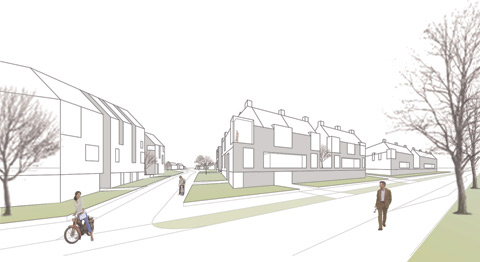ATELJE PRELOVŠEK
architecture_urbanism_interior design
projects studio info news contact
architecture urbanism interior design
<<< back to list of urbanism
-------------------------------------------------------------------------------- LANDLINES JÄRVENPÄÄ
Europan 10, new residential district, Järvenpää, Finland

Project description: Project
was designed as 7 steps towards
sustainable district. Steps were derived from the traditional western
Finnish building islands in the form of courtyards that allow common
outdoor spaces. Neighborhood lies near the railway, therefore its
density is increasing towards the train station area. Housing units are
compact and therefore provide conditions
for low energy consumption. Small plots with dense arrays make it possible to
preserve open countryside to the maximum degree, for both recreational and
agricultural purposes.
Location: Järvenpää, Finland
Size: 557 apartments, 99.658 sqm (total gross building area), 155.235 sqm private plot areas, 155.700 sqm public spaces
Project phase: competition
Year of the project: 2009
Authors: Eva Prelovšek Niemelä, Aarne Niemelä
AWARD
Project received 2nd prize (runner-up).

LandLines are strips of
semi detached and family houses that are connecting the close railway
area with the open field in direction towards the lake. Along the
strips of housing there are strips of green areas and large green
public spaces. In the middle of the district there is urban park (with
playgrounds for children) along the existing water stream, which is
transformed into broader water area.


SEVEN STEPS TOWARDS SUSTAINABLE DISTRICT
STEP 1
REVIEW OF VERNACULAR BUILDING FORMS: COURTYARDS

Traditional
Finnish farmhouses with closed courtyards (»umpipiha«) were mainly
built in western Finland from the Middle ages until 19th century. A
typical model of a farmhouse complex included two rectangular
courtyards: one for animals, the other for humans, surrounded by
residential and service buildings of the farm. Important storage
buildings (granaries) and non-fireproof buildings (saunas, forges) were
usually placed outside the dense main complex.
This
form of traditional Finish farmhouses formed island groups in landscape
that were used by different users. Shared interior of the courtyard
protected people from weather and beasts and created positive density
in open landscape.
STEP 2
REINTERPRETATION OF THE COURTYARDS: SUSTAINABLE DISTRICT IS DENSE DISTRICT

Courtyards
are positive density where people share a part of their outdoor private
space with each other. Entrances into the courtyards are made with
subtle borders, avoiding fences and doors. Safe district does not mean
gated district, but being able to see and share what is happening
outside someone’s house.
STEP 3
FLEXIBILITY OF THE LIVING SPACES: APARTMENT AS A LOFT

Sustainability
is also flexibility of use. Apartments should be designed in the way
that they are able to accept the differences of needs of users during
their life span. Loft apartments are undetermined spaces where only
core with installations is fixed, the rest remains flexible.
STEP 4
RECOGNITION OF THE PROFILES AND NEEDS FOR DIFFERENT USERS

STEP 5
CREATING COMPACT VOLUMES THAT HAVE OWN ENTRANCES FROM THE GROUND FLOOR

Sustainable
building is compact and allows energy saving for heating. Volumes are
designed with extra spaces (mostly) above garages that can offer open
terraces with orientation in two directions or greenhouse- (glazed)
extension on the terrace. Greenhouses provide living units with heating
through solar energy.
All units have it’s entrances from the ground floor which offers also
in higher density block small private plots- gardens. Growing plants in
gardens means also more connection with the nature and consciousness
about it’s protection. In this district every living unit has its own
garden.
STEP 6
COMPLETE REUSE POSSIBLE

Sustainable
building allows complete reuse if the economical situation after some
years of use shows that other use of building would be more needed for
the district.
STEP 7
SUSTAINABLE DISTRICT PLANNING



Situation plan

Urban block: mixed semi-detached houses and houses on top of the garage. Garage serves as buffer to railway-noise.

Courtyard: Mixed semi-detached and family houses.
Family houses are connected by garages, semi detached houses have
shared garages. Semi private area in the courtyard is open space shared
by surrounding houses. There is place for playground for children,
picnic space, trampoline, fruit trees... Living in the courtyard type
enforces the communication among neighbors, it is dense and sustainable
typology.

Family houses:
Buildings are connected with garages, which can be also shared by two
neighboring houses. There are terraces on top of the garages that can
be also transformed into glazed greenhouses. Family houses are placed
in a dense district that opens towards free agricultural landscape.

--------------------------------------------------------------------------------
<<< back to list of urbanism

















